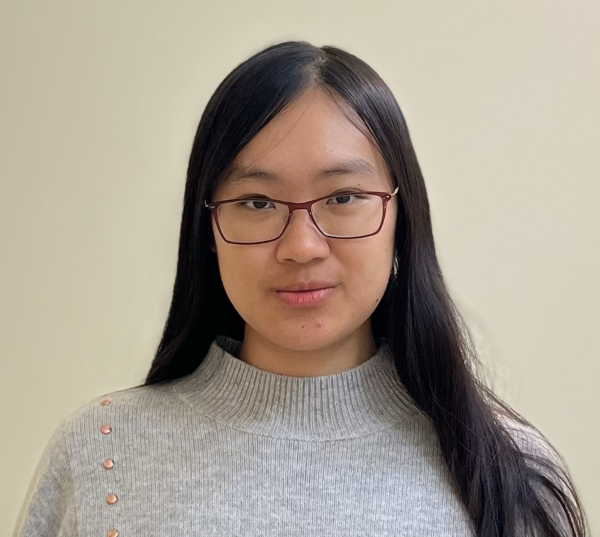Through April 21, the visual arts B.A. thesis exhibition ARACHNIDAE showcased the work of eight undergraduate artists who will be graduating this June. A curiously woven patchwork of materials, moods, and moments, each piece stood simultaneously on its own, within its artist’s collection of works, and in the midst of the exhibition as a whole.
Some of the pieces are literal patchworks. Julia Fennell’s paintings are done on sewn-together pieces of canvas, mosaics of psychedelic colors. They are a strange kind of nostalgic, depicting living rooms and childhood beds and butterflies. Wide angles and exaggerated proportions unbalance and reframe the world. Something is just beyond reach—or perhaps is just coming into being among the swirls of paint.
A large, column-like structure stood in the middle of the room with paintings on each of its four sides. Some of those paintings were Jordan Yi’s works. Evocative of mythology and fantastical worlds with a distinctly gory tint, the oil paintings feature hares, birds, and other animals. There is a current of indistinct violence and ominous energy that runs through the paintings, which unsettles the softness, elegance, and, frankly, cuteness of Yi’s animal subjects. Looking at the works, I’m pulled into a kind of captivating quiet chaos—into a world I can’t quite understand, but that I feel compelled to look deeper into.
The exhibition also featured a striking array of other artistic media beyond painting. Isabella Diefendorf’s evocative sculptures and installations were scattered throughout the room. Suspended from the ceiling, foraged branches are held by strings of yarn in a delicately balanced structure reminiscent of spiderwebs. Some branches, two with the translucent halo of a disc caught between their tips, wave shadows on a wall. An entire world is distilled into a jar filled with rainwater that has run off a work of chalk art. Diefendorf’s work seems to bring the outside back in, capturing and recreating natural phenomena in a new form.
Natalie Jenkins offers another take on sculpture. Blurring the line between artificiality and nature, Jenkins’s works often juxtapose natural forms with sharp, geometric lines. Roots and bark and stones are pinned against grids, and yet seem unable to be contained by these grids. Cacti carved of insulation foam stand in buckets, awash in a sea of overflowing sand. Time, in a way, is suspended, and growth and change held in place for a moment.
I was halfway around the room when I noticed the black curtain on one side of the center column. Some of the sounds I’d heard when I entered the exhibition emanated from within. Behind the curtain was the pocket of experience that Otis Gordon created. In the corners of the dim space are cylindrical lanterns, translucent with distorted faces printed on them. They cast a flickering, obscure, orange-tinted light on oil paintings of buildings and more faces. One of them, with its spectacled eye warped as if through a fisheye lens, peers down at me. I feel on edge, out of place—a newcomer in a cold, unsettling city. There is the sound of wind, a static buzzing, soft music, and noises that sound like crying or laughing or maybe the screaming of an animal. I am both relieved and reluctant to escape back through the black curtain from Gordon’s immersive and alien world to the bright white walls of the rest of the exhibition.
Marbling through some of that whiteness were the drawings of K. Thornburgh-Mueller. Pages of white card paper are covered in lines that are a little like human or animal figures, a little like faces, and a little like nebulae all at the same time, held up with metal screws and bars over one wall. The lines strain against the bars with the same sense of motion and ephemerality as birds in flight. Another one of Thornburgh-Mueller’s drawings is done on a handmade sheet of paper taller than a person. The work truly embodies the word “battered”—it is pockmarked with holes and torn edges, dark tendrils wisping across the surface in a melancholy fashion.
Thornburgh-Mueller’s black and white drawings were contrasted by the neon green and burgundy color scheme of one of Leah Chappell’s oil paintings. A medical patient with a device strapped to their head stares at the viewer from within a slime-colored doctor’s office. The device is connected by artery-like wires to a monitor. What’s going on? Chappell’s disquieting piece leaves us with more questions than it answers. Another of Chappell’s paintings portrays a pale, beheaded sculptural figure reminiscent of a Hellenistic marble, albeit with its color scheme, posture, and body proportions not altogether right, combining to be just a little eerie.
As I was about to leave the exhibition, I noticed the little theater tucked near the entrance. Yisong Tang’s “Tars, Ears, and the East,” the only work of film in the exhibition, was playing inside. “Alright, let’s start over again,” says a voice in Chinese at the beginning of the film, as if self-conscious of the work’s own looping repetition. Son and father commence counting through the multiplication table, each number they recite marking the passage of time as memories and rhythms of emotion weave into one another. Music flows throughout the film, but there is a conspicuous absence of talking outside the steady pace of the times tables—there is much, perhaps too much, left unsaid as the pair within the film inhabit their tense bubble of a universe. The camera roves across dark trails of filled-in cracks in the asphalt and lingers on the two faces of father and son. Tang’s portrayal of this relationship is both universal, yet intensely personally and culturally anchored.
As a whole, ARACHNIDAE was somewhat disorienting, but full of variety and personality and plenty of surprises to stumble upon. And, as the exhibition website describes, it captures a moment in time for each of the eight student artists—like “the fleeting instance when a fresh spiderweb catches the sunlight and glimmers like fire.”









